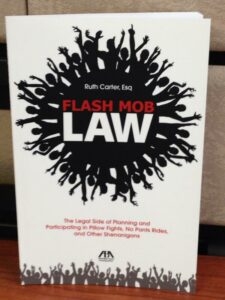In my last post, I told you about my plans to write two new books next year.
Then I had lunch with Jeff, and now my plans have changed significantly.

Jeff Moriarty is one of the most creative people I know. He has a gift for developing and executing ideas. He is the founder of Ignite Phoenix and a co-founder of Improv AZ. I often refer to him as my partner in crime. (Note: We are partners in crime, not partners in life. I have no idea how his wife puts up with all of his puns.) Jeff is also a talented writer and has substantial knowledge about indie publishing. He and Evo Terra ran a company called ePublish Unum that helped indie authors (including me) write and release their books.
I told Jeff about my ideas to write two books next year, and he made the brilliant suggestion that instead of writing two comprehensive books, I could write several shorter ebooks where each one tackles a smaller subtopic within social media law. This would allow me to create and release more book-quality content throughout the year and delve into specialized topics for niche audiences. After releasing several of these short books, I could create a compilation of material from several books and release that as an ebook or in print (most likely print-on-demand).
This idea makes perfect sense for my ideas. I have been struggling with how I was going to fit so many different topics into two books – especially social media law for small businesses because there are so many different groups within that audience I want to help.
In listening to Jeff, my brain was already cranking out ideas – like using a similar cover design for each book, but in a different color, much like what ePublish Unum did with their books about indie publishing.
Originally, I thought I wanted a traditional publisher for my next books, but now I’m thinking of going back to my indie publishing roots. I will still have an editor and a graphic designer; and I may hire a company to format my books. But beyond that I can release my work myself, on a schedule that I set, with total autonomy regarding the topics I cover. And if I don’t have a traditional publisher, there will be no question or debate about who owns the copyright (me) and I can set my own prices. (Translation: I can charge less than what a traditional publisher would charge because I won’t have to share the profit with them.)
So now my next step is to decide what topics I want to cover in my next batch of work, and start figuring out how many e-books I will be writing next year as a result. I have a feeling this means I’m going to have a wall covered in sticky notes in the near future.

